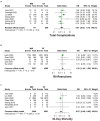Minimally invasive surgery vs. open thoracotomy for non-small-cell lung cancer with N2 disease: a systematic review and meta-analysis
- PMID: 37324136
- PMCID: PMC10265993
- DOI: 10.3389/fmed.2023.1152421
Minimally invasive surgery vs. open thoracotomy for non-small-cell lung cancer with N2 disease: a systematic review and meta-analysis
Abstract
Background: This meta-analysis aimed to investigate the effectiveness and safety of minimally invasive surgery [MIS, including robotic-assisted thoracoscopic surgery (RATS) and video-assisted thoracoscopic surgery (VATS)] and open thoracotomy (OT) for non-small cell lung cancer (NSCLC) patients with N2 disease.
Methods: We searched online databases and studies from the creation of the database to August 2022, comparing the MIS group to the OT group for NSCLC with N2 disease. Study endpoints included intraoperative outcomes [e.g., conversion, estimated blood loss (EBL), surgery time (ST), total lymph nodes (TLN), and R0 resection], postoperative outcomes [e.g., length of stay (LOS) and complication], and survival outcomes [e.g., 30-day mortality, overall survival (OS), and disease-free survival (DFS)]. We estimated outcomes using random effects meta-analysis to account for studies with high heterogeneity (I2 > 50 or p < 0.05). Otherwise, we used a fixed-effect model. We calculated odds ratios (ORs) for binary outcomes and standard mean differences (SMDs) for continuous outcomes. Treatment effects on OS and DFS were described by hazard ratio (HR).
Results: This systematic review and meta-analysis of 15 studies on MIS vs. OT for NSCLC with N2 disease included 8,374 patients. Compared to OT, patients that underwent MIS had less estimated blood loss (EBL) (SMD = - 64.82, p < 0.01), shorter length of stay (LOS) (SMD = -0.15, p < 0.01), higher R0 resection rate (OR = 1.22, p = 0.049), lower 30-day mortality (OR = 0.67, p = 0.03), and longer overall survival (OS) (HR = 0.61, P < 0.01). The results showed no statistically significant differences in surgical time (ST), total lymph nodes (TLN), complications, and disease-free survival (DFS) between the two groups.
Conclusion: Current data suggest that minimally invasive surgery may provide satisfying outcomes, a higher R0 resection rate, and better short-term and long-term survival than open thoracotomy.
Systematic review registration: https://www.crd.york.ac.uk/PROSPERO/, identifier: CRD42022355712.
Keywords: N2 disease; minimally invasive surgery; non-small cell lung cancer; robotic-assisted thoracoscopic surgery; video-assisted thoracoscopic surgery.
Copyright © 2023 Liu, Li, Tang, Chen and Qiao.
Conflict of interest statement
The authors declare that the research was conducted in the absence of any commercial or financial relationships that could be construed as a potential conflict of interest.
Figures






References
-
- Yan TD, Black D, Bannon PG, McCaughan BC. Systematic review and meta-analysis of randomized and nonrandomized trials on safety and efficacy of video-assisted thoracic surgery lobectomy for early-stage non–small-cell lung cancer. J Clin Oncol. (2009) 27:2553–62. 10.1200/JCO.2008.18.2733 - DOI - PubMed
Publication types
LinkOut - more resources
Full Text Sources
Miscellaneous

